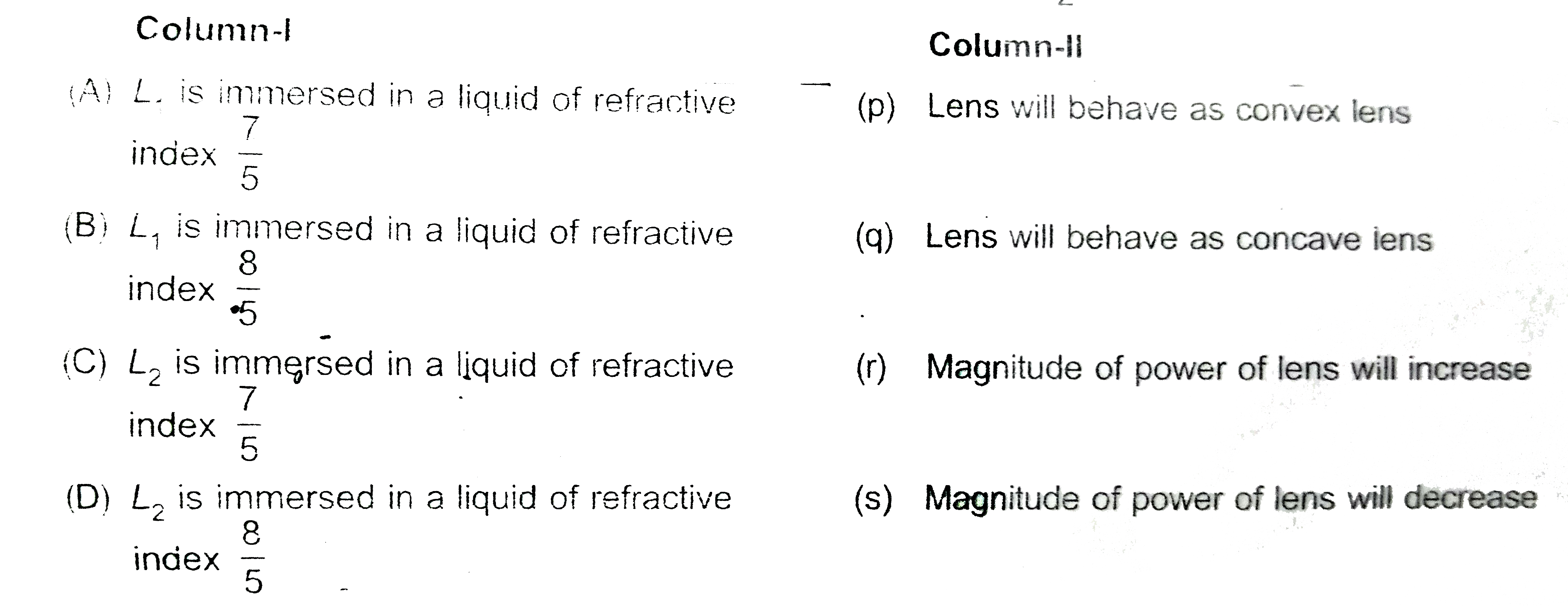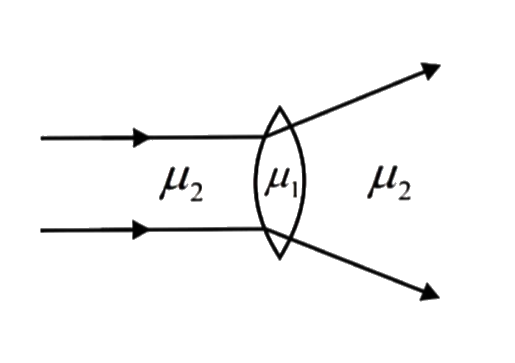Two light waves having the same wavelength λ in vacuum are in phase initially. Then the first ray travels a path of length L1 through a medium of refractive index μ1. Then second ray travels a path of length L2 throug a medium of refractive index μ2. The two waves are then combined to observed interference effects. The phase difference between the two, when they interfere, is
2πλ⋅(L2−L1)
2πλ⋅(n1L1−n2L2)
2πλ⋅(n2L1−n1L2)
2πλ⋅(L1n1−L2n2)
The correct Answer is:B
To find the phase difference between two light waves after they have traveled through different media, we can follow these steps:
Step 1: Understand the Optical Path Length
The optical path length (OPL) for a light wave traveling through a medium is given by the product of the refractive index of the medium and the physical path length traveled by the light in that medium.
For the first wave traveling through a medium with refractive index μ1 and path length L1:
OPL1=μ1L1
For the second wave traveling through a medium with refractive index μ2 and path length L2:
OPL2=μ2L2
Step 2: Calculate the Path Difference
The path difference Δx between the two waves when they are combined is given by the difference in their optical path lengths:
Δx=OPL1−OPL2=μ1L1−μ2L2
Step 3: Relate Path Difference to Phase Difference
The phase difference Δϕ corresponding to a path difference can be calculated using the formula:
Δϕ=2πλΔx
Substituting the expression for path difference:
Δϕ=2πλ(μ1L1−μ2L2)
Final Result
Thus, the phase difference between the two waves when they interfere is given by:
Δϕ=2πλ(μ1L1−μ2L2)
The optical path length (OPL) for a light wave traveling through a medium is given by the product of the refractive index of the medium and the physical path length traveled by the light in that medium.
OPL1=μ1L1
OPL2=μ2L2
The path difference Δx between the two waves when they are combined is given by the difference in their optical path lengths:
Δx=OPL1−OPL2=μ1L1−μ2L2
The phase difference Δϕ corresponding to a path difference can be calculated using the formula:
Δϕ=2πλΔx
Substituting the expression for path difference:
Δϕ=2πλ(μ1L1−μ2L2)
Thus, the phase difference between the two waves when they interfere is given by:
Δϕ=2πλ(μ1L1−μ2L2)
Topper's Solved these Questions
Similar Questions
If light travels a distance of 5 m in a medium of refractive index μ, then equivalent path in vaccum it would travel in same time is
View SolutionA lens made of material of Refractive index μ2 is surrounded by a medium of Refractive Index μ1. The focal length f is related as
View SolutionA lens made of material of Refractive index μ2 is surrounded by a medium of Refractive Index μ1. The focal length f is related as
View SolutionLight of wavelength λ0 in air enters a medium of refractive index n. If two points A and B in this medium lie along the path of this light at a distance x, then phase difference ϕ0 between these two point is
View SolutionTwo parallel rays are travelling in a medium of refractive index μ1=4/3. One of the rays passes through a parallel glass slab of thickness t and refractive index μ2=3/2. The path difference between the two rays due to the glass slab will be
View SolutionA ray of light with wavelength 5000 nm travelling from a medium with refractive index (32) suffers partial reflection and refraction in a medium of refractive index (43). Find wavelength of reflected and refracted ray.
View SolutionA convex lens L1 and a concave lens L2 have refractive index 32. Match the following two columns.
 View Solution
View SolutionA ray of light, travelling in a medium of refractive index 'mu_, is incident at an angle i on a composite transparent plate consisting of three plates of refractive indices μ1,μ2andμ3. The ray emerges from the composite plate into a medium of refractive index μ4, at angle x. Then,
View SolutionLight waves of wave length λ propagate in a medium. If M end N are two points on the wave front and they are separated by a distance λ/4, the phase difference between them will be (in radian)
View SolutionA thin bi-convex lens made out of a material of refractive index μ1 is place in a medium of refractive index μ2. A paraxial beam of light, parallel to the principal axis of the lens, is shown in the figure. Based on the ray diagram, we can conclude that
 View Solution
View Solution
